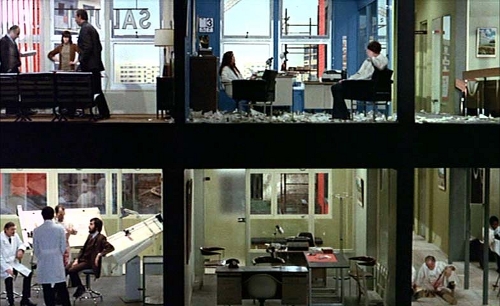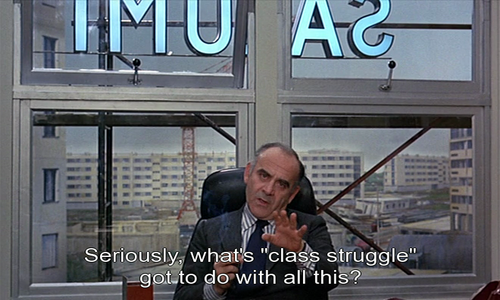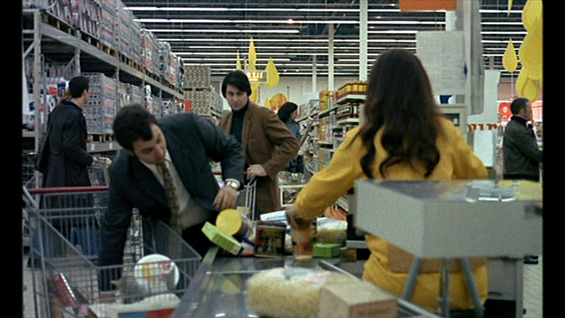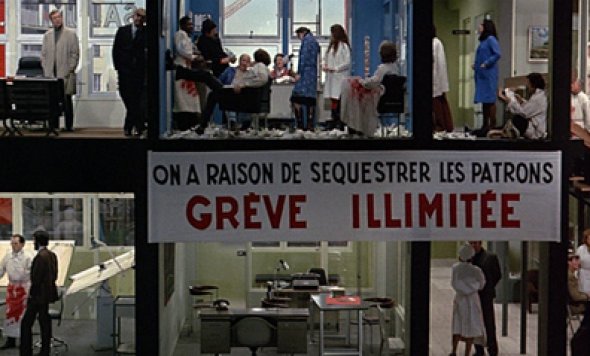The Missing Factory
Buy on Amazon UK £9.99 and other regions, Super Saving free shipping.
As the financial crisis fastens its grip ever tighter around the means of human and natural survival, the age of the algorithm has hit full stride. This phase-shift has been a long time coming of course, and was undoubtedly as much a cause of the crisis as its effect, with self-propelling algorithmic power replacing human labour and judgement and creating event fields far below the threshold of human perception and responsiveness.
In the early 1970s, at the meeting point of workplace occupations and critical film-making, 20th century art's attraction to the factory reached a representational impasse. Taking up Harun Farocki’s idea that factory work has been systematically expunged from cinema, John Roberts considers why this hegemonic site of value-production must remain absent from film and bourgeois culture more generally
In an interview Jean-Luc Godard conducted after the release of Tout Va Bien (1972), during the time of his participation in the Dziga-Vertov Group, which he co-founded with Jean-Pierre Gorin, he argues, in direct opposition to the reception of the film on the left, that his film was not a film that spoke for workers, and neither did he, more generally, as a film-maker. ‘Rather than speaking in the “name of” we should speak in our own name.’1 Thus at the moment of his self-designation as a political film-maker he rejects the partisanship of the artist as anything so simplistic as a calling-up to the workers’ movement. This distinction is important, and in a sense established the political trajectory of his career: it is the political task of artists – their job as partisans – to speak as artists, not as workers’ emissaries. In an interview 35 years later, however, he places a quite different emphasis on the representation of workers’ lives: the working class does not want to see images of itself labouring, he says, and therefore any film-maker who inflicts this on their audience is in direct contravention of the spirit of cinema. ‘The worker would be bored to tears if he had to watch himself. People don’t want to see their lives, only a little bit of their lives.’2 At one level this seems superficially conservative, and even a betrayal of the earlier comment, but at another level it confirms what Harun Farocki’s has called cinema’s fundamental resistance to the factory. As Farocki says in the essay accompanying his film Workers Leaving the Factory (1995), a compilation of footage of workers leaving the factory gates culled from feature, documentary, news and advertising films: ‘Most narrative films take place in that part of life where work has been left behind.’3 That is, film begins when in imagination and actuality, the audience have disconnected from their labours, and the labours of others. Indeed in a brilliant allegorical interpretation of the Lumière brothers Workers Leaving the Lumière Factory in Lyon (1895) – to the best of our knowledge the first projected film – these first flickering images prefigure the very history of cinema as the encapsulation of this leaving, as if the Lumière brothers had invited the workers, on their sprightly emergence into the sunlight, to become cinema as opposed to returning to their lives as living labour.
But if cinema, in these terms, is the space that leaves the factory behind, this is not because cinema has not wanted to enter the factory at all and film from the opposite perspective: workers streaming into the factory (as in Karel Reisz’s, Saturday Night, Sunday Morning (1960)). In fact, in the same 1972 interview Godard bemoans the fact that ‘there’s hardly anywhere I can shoot’ (and of course he’s right). If the cinema is also the imaginary opposite to the factory as a condition of the audience’s liberation from waged labour, it is also the place where the production of representation is itself blocked. Firstly, as a consequence of the discipline of the production line, and the pressures of the value-form more generally (the demands of continuity and efficiency). Factory managers do not want documentary film-makers or Hollywood producers disrupting the flow of production, and certainly do not want film-makers asking questions that might reflect badly on worker-management relations. Similarly in fictive reconstructions of the factory, the noise, intense repetitive labour and, as such, the enforced silence of workers at the point of production, make the social interactions of workers on the shop floor a dramatic dead zone. Moreover, we shouldn’t assume that these conditions are any less oppressive today and, therefore, that the facticity of these conditions is any less powerful. These conditions remain as widespread under post-Fordism as they did under Fordism, with the arrival of the mega-Fordist factory in the East and South (China, India and Russia). To present workers' speech in the factory, therefore, is to either denaturalise the conditions of this enunciation – to allow workers to speak when they are unable realistically to speak – or to present speech as moments of respite from the intensity and repetitions of labour (something that narrative cinema, say in the workshop scene in a prison movie such as The Shawshank Redemption, is particularly adept at).
So, under these conditions labour can only be seen and not represented (in the words of workers themselves), and as such, filming soon surrenders itself to the inertial drag of repetitive labour – that is, at the risk of abandoning the representation of the intensity of the factory altogether. In short, the factory is the place where representation cannot freely move. And we see this tension in Godard’s own reconstruction of the meat products factory in Tout Va Bien. Workers speak – as workers – insofar as they are not working, namely striking. That is, the strike at the factory allows Godard to abandon naturalism, inviting the workers (who are played by unemployed actors in the film) to direct their demands and grievances directly to camera, in neo-Brechtian style. If he had staged this at the point of production itself, with workers stopping their labour to speak directly to the camera it would have likely turned the action into the equivalent of a revue, familiar from the comedic anti-naturalistic break in action in a musical, in which the actor switches, with light-hearted and implausible dexterity, from one activity to the next. So, in Tout Va Bien the representation of labour – of the capital-labour relation – begins precisely when the labour of the factory has stopped. Consequently, we might say, the representation of the factory begins, or can begin, once we no longer see the factory working, when the production of value is interrupted.

All images: Jean-Luc Godard and Jean-
As such this seems to stage a counterweight to that of Farocki’s cinema/factory dyad: labour has to stop before it can be represented, that is, before workers are able to establish the conditions for their own autonomous speech. No wonder then that the factory is a symbolic dead zone: inside its disciplinary boundaries the labour process and value-form destroys representation and ultimately expels the camera.
This gives us, notionally, a couple of axioms, to work with.
Firstly:
The non-representation of the labour process and workers’ speech inside the factory is the obverse of workers’ resistance, or indifference outside of the factory, to the representation of their own labour.
And, secondly:
The outcome of this interconnection is that productive labour and the factory cannot be made compatible with the symbolic.
For capital: this is because the entry of representation into the factory destabilises the value process, and therefore has to be excluded and suppressed. For labour: this is because the representation of labour means workers are being encouraged to take pleasure, or pedagogic instruction, from their own alienation, and therefore, the representation of labour, when encountered, has to be ‘walked away from’.

This symbolic closure or unavailability of the factory, is, of course, part of a broader shift in the labour process that Godard himself touches on in Tout Va Bien: the symbolic deposition of the factory from the forefront of the traditional labour imaginary as a consequence of two interrelated forces that were just becoming visible in the early 1970s: the beginning of post-war capitalism’s competitive contraction of its industrial base, or deindustrialisation, as a consequence of the increased productivity of labour (what Marx calls the rising organic composition of capital), and the notion of the ‘social factory’ made popular in the ’70s by autonomists and Italian workerists (the notion that the disciplinary conditions of the factory apply to all places of work, productive and non-productive alike, and most contentiously to the sites of cultural consumption, such as the museum and the cinema). We see this most obviously at the end of the film in the camera’s long slow tracking shot back and forth behind the checkout tills in the supermarket, in which shopping is shown to be as regulated and disciplined as the labour process in the factory. In these terms, the non-representation of the factory is, from the early 1970s, increasingly underwritten by the symbolic dissolution of the classic Fordist labour process; the discipline of the factory is held to be constitutive, at varying levels of intensity, of all social relations.
So, if the representation of the factory cannot be made compatible with the symbolic, or made so indeterminate as to become symbolically empty, where is the factory today? How is the missing factory to be mediated? But if these questions sound necessary and plausible, they are also the wrong questions to ask, for the factory is not waiting for representation to make a breakthrough, or for the emergence of better conditions in the factory for representation. This is because the factory, being the site where cultural relations cannot enter fully, represents, in its absent symbolic condition, something far more important: the eventual (and evental) site of bourgeois culture’s dissolution. Thus, mourning the missing factory misses why the factory has to remain missing under current conditions: that is, it reveals the limits to the bourgeoisie’s enculturalisation of the world, and as such moves us beyond the notion that somehow representation of the factory can begin once the exertions of labour power stop.
For the factory to enter the symbolic – as with any other social location and practice – it has to be brought stably under control, as part of the narrative self-representation of capitalist relations. And key to this narrative stabilisation is the generation of a conflictual dynamic, in order to make the interrelations between characters plausible, and their desires believable as part of capitalist relations. The factory, therefore, provides a conflictual dynamic that cannot be brought stably under control, insofar as this conflict is fundamental and irreconcilable. This is why historically there is no shortage of glimpses into labour-capital conflict inside the factory in film and photography, but these glimpses cannot be made consistent or persistent, because for this to happen, these glimpses would have to become definitional of the place of labour in the symbolic order and therefore a representative part of it: cinema, the real life of labour and the symbolic would become co-extensive. Consequently, for labour to become a representative part of the symbolic order it would have to dissolve what capitalism disavows: the constitutive split between labour and capital – and this is plainly impossible, indeed, an inversion of the social fact of labour power as a determinate absence. But this is not to deny the distancing and veiling effects of ideology as part of this process: bourgeois culture cannot incorporate its proletarian critique in its own symbolic reproduction, because to do so is to assume that the symbolic has no material limits and no interested parties. Capital can certainly expose the violence of class relations as part of its symbolic reproduction, but it cannot speak for labour. Moreover, if the representation of labour power could break through its own determinate absence under capitalism, and the real life of the factory was able to achieve representativeness, the same short-circuiting of the cinematic experience would still apply: how many films can be made on factory life and struggle when the truth of the factory becomes openly identifiable with the social truth of labour power itself? What possible value might such transparency serve politically and culturally, when its truth has become compatible with empirical appearances and ‘common sense’? So, in the first instance the representation of the factory is symbolically empty, because its truth is incompatible with proletarian desire, and in the latter case the factory is symbolically empty because it is superfluous to scientific knowledge.

The problem, therefore, for bourgeois culture is not the outright symbolic repression of the factory, or its transformation into a place of equanimity and harmony, for this is to precisely betray the cinema audience (no worker or even non-worker would find either position acceptable), insofar as it would dissolve the conflictual demands of narrative as such. The ‘solution’, rather, is to make productive labour, particularly factory labour, the thing that we see (occasionally), but which is not visible – in the sense Lacan articulates in his discussion of the invisible/visible object in the ‘Purloined Letter’.4 In other words, the missing factory is not just about conditions of access, but of making visible what cannot be seen. That is, in these terms: what is seen is not visible, and what is visible is not seen, allowing what is to be seen, when it is seen, to be seen without consequence, without full symbolic assimilation. The factory is certainly seen, glimpsed publicly – because the alternative is outright repression or irenic pacification, discordant with the demands of narrative conflict – but not made consistently visible, that is, not actively represented. The factory then is not waiting to be represented at all, (in order to reinstate the worker within the symbolic), but, rather, in a more properly transformative and emancipatory way waiting to be dismantled. Hence, the representation of the factory, will occur precisely in the process of this dismantling, when its abstract identity as the disciplinary home of the value-form is dissolved.
As such, the factory’s relationship to cultural transformation has a far more exacting function than overcoming its blocked entry into the symbolic: it becomes the actual site of emancipatory transformation itself. There is something of this logic in the early years of the Russian revolution, when the factory was briefly at the centre of the imaginative reconstruction of the labour process, or more broadly the Communist Imaginary. For a few years, under the auspices of Constructivism and Productivism, artists entered the factory – or tried to enter the factory – in order to exercise what they hoped to be the beginning of the revolutionary transformation of the relations of production. There were two critical components to this: the possible contribution that artists, engineers and designers might make in improving the production process, and the more radical and oppositional position, the collaboration between artists and workers in the dissolution of the value-form and the eventual dismantling of the factory in its present manifestations. Neither was successful. Rather, the latter was mostly subjected to the former, artists realising that the only transformation of the factory that the labour process would facilitate – certainly under the New Economic Policy (NEP) – was improvement in labour efficiency.5
Yet, as the hierarchical site of labour-capital relations and the value-form, the factory remains where ‘aesthetic thinking’ as the critique of the value-form must enter eventually. And it must enter, first and foremost, unencumbered with the notion that the liberation of art from bourgeois relations is compatible with its entry into the labour process – a recurring fantasy of those who would want to ally artistic labour completely with general social technique. The factory, therefore, contra the Soviet productivists of the 1920s, is not the primary site of art’s use-values (the place where art will fully emancipate itself through productive labour and its instrumental outcomes), but rather the destinal site of art’s critique of the value-form. Consequently, the factory is the place where free labour (inscribed in art) must arrive some time in order to confront and challenge the alienations and routinisations of productive and non-productive labour itself – material and immaterial alike. How this will happen and under what terms is unknown, but whatever forms it will take, the working class will have a direct say in their outcomes.6
Info
A version of this article was presented in discussion with Sam MaCauliffe as part of the film screening series, ‘Factory Trouble’ at Goldsmiths, organised by Manu Ramos, in 2011, and at the Historical Materialism Conference, No 8, at SOAS, 2011.
John Roberts <jcr3 AT wlv.ac.uk> is Professor of Art & Aesthetics at the University of Wolverhampton, and is the author of a number of books, including The Intangibilities of Form: Skill and Deskilling in Art After the Readymade (Verso, 2007), and The Necessity of Errors (Verso, 2011)
Footnotes
1 Jean-Luc Godard interviewed about Tout Va Bien: http://www.youtube.com/watch?v=hnx7mxjm1k0
2 'Interview with Jean-Luc Godard by Emmanuel Burdeau and Charles Tesson', in Jean-Luc Godard, The Future(s) of Film: Three Interviews, 2001/01, John O’Toole (trans.), Bern and Berlin: Verlag Gachnang & Springer, 2002.
3 Harun Farocki, ‘Workers Leaving the Factory’, Senses of Cinema, Issue 21, July/August 2002.
4 Jacques Lacan, ‘The Purloined Letter’, in The Seminar of Jacques Lacan: Book II, The Ego in Freud’s Theory and in the Technique of Psychoanalysis, 1954-1955, Jacques-Alain Miller (ed.), Sylvana Tomaselli (trans.), with notes by John Forrester, New York and London: W.W. Norton & Company, 1991.
5 See Maria Gough, The Author as Producer, Berkeley: University of California Press, 2005.
6 John Roberts, ‘Productivism and Its Contradictions’, Third Text No 100, Vol.23 No.5, September 2009, p.536.
Mute Books Orders
For Mute Books distribution contact Anagram Books
contact@anagrambooks.com
For online purchases visit anagrambooks.com








